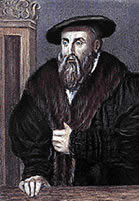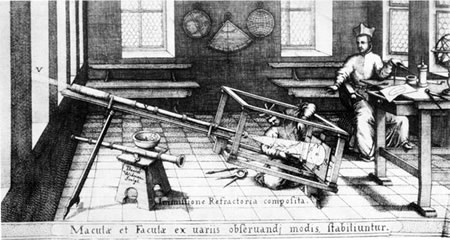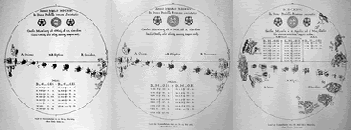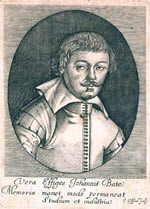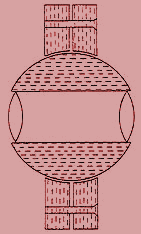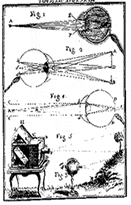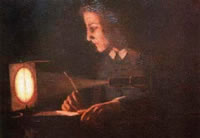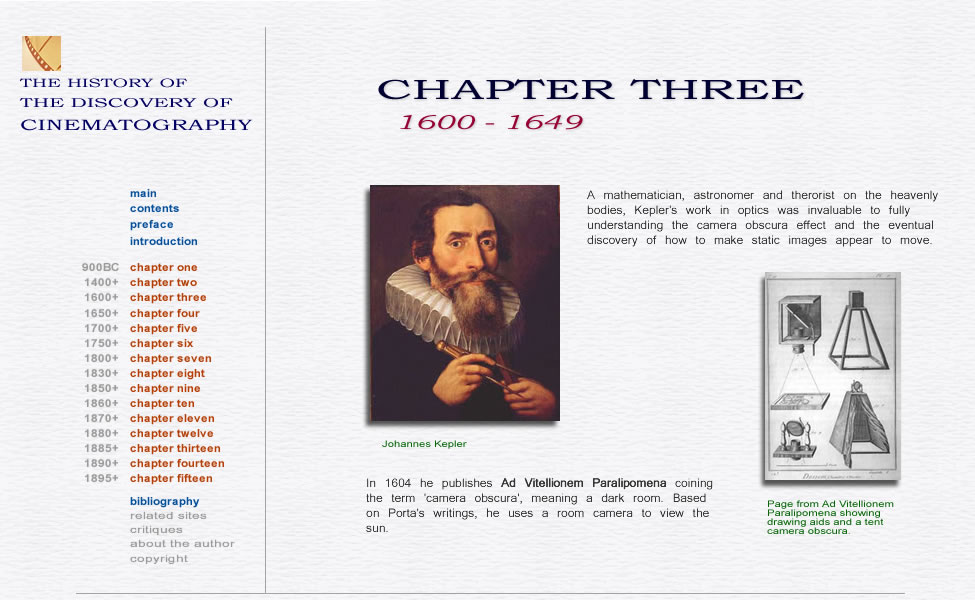 |
| |
|
|
|
| |
|
|
| |
The camera obscura and
the magic lantern maintained individual followings right up to the 20th
century. Many of the most important characters in this story are now revealed
as we see how the camera and lantern independently of each other, continue
to bind the curiosities into legitimate forms of entertainment as well
as aids in art. Men such as Kepler, Scheiner and Horrocks, working primarily
in the study of the heavens consider the camera's uses in this and in
other disciplines. |
|
| |
|
|
|
| |
|
|
|
| |
|
|
| |
|
|
| |
1600
JOHANNES KEPLER (1571 - 1630)
This
Jesuit scholar, astronomer and assistant to Tycho Brahe (1546-1601)
wrote about observing the sun using a room camera similar to the
one described by Porta. Kepler described this event in his first
published work on astronomy, 'Ad Vitellionem Paralipomena'
(Supplement To Witelo, Kepler, J., Frankfurt, Germany, 1604,
p51). The first occurrence of the name "camera obscura" is
found in this work.
Johannes Kepler (right)
(1571-1630) coined the phrase 'camera obscura'.
The first occurrence of it's use is found in his 'Ad Vitellionem
Paralipomena' of 1604. In 1609 Kepler suggested the use
of the lens to improve the image. |
|
|
|
| |
|
| |
| |
|
|
| |
|
|
|
| |
|
|
|
| |
1602 - 1604
VINCENZO CASCIOROLO or CASCARIOLO ( - ) |
|
|
| |
This Italian shoemaker
and part alchemist came upon barium sulphide (also known as lapis solaris
or bologna stone) in the town of Bologna where it was plentiful. He found
that it became luminous when added to hot coals. Also known as 'sunstone',
barium sulphate was phosphorus, meaning "light bearer". This term was
now applied to any substance which would glow. |
|
| |
|
|
|
| |
|
|
|
| |
1607
JOHANNES KEPLER (1571 - 1630) |
|
|
| |
Kepler uses the camera
to observe the transit of Mercury. He would say during his life on the
topic of invention . . . "I much prefer
the sharpest criticism of a single intelligent man to the thoughtless
approval of the masses".
|
|
| |
|
|
|
| |
|
|
|
| |
|
|
| |
|
|
| |
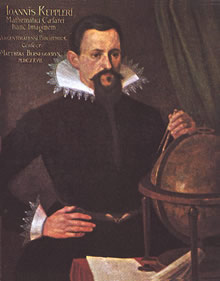 |
1609
JOHANNES KEPLER (1571 - 1630)
His
use of the telescope in this year was the foundation for his 'Dioptrice'
(Concerning Lenses, Kepler, J., Augsburg, Germany, 1611, ch.XLIII,
p16) which suggested improvements to the room camera using
the lens. This manuscript (Opera Omnia, Kepler, J., vol.II,
p549-555) by Kepler also shows the advantage of amplified
projection, biconvex (ocular) lens and inverting the image.
In
Kepler's 'Dioptrice' (left) he talks of
the image in the room being improved if a lens is used which would
invert the image. Kepler also mentions amplifying the projection
as an advantage. Dioptrice ('Concerning Lenses') was published
in 1609. |
|
|
| |
|
|
| |
|
|
| |
|
|
|
| |
|
|
|
| |
1610
CHRISTOPHER SCHEINER (1575 - 1650)
This
German Jesuit and pupil of Kircher designed and built what he
called his "Pantograph" (also see 1611-1612) or, device
for making optical copies. He illustrated this instrument in his
'Rosa Ursina Sive Sol' (Scheiner, C., Bracciano,
Italy, 1630, Book II, ch.8, p107, and plate).
The next year he would observe sunspots. It is difficult to see
in the image to the right, but the viewer is on the far side of
the camera and has his head inserted in the device, and completing
the drawing. |
|
| Christopher
Scheiner's 'Pantograph' (above right ). The telescopic
lens mounted in the front of the box (camera), can be seen extending
out the window. It is believed the device was 22 metres long.
The image of the sun, and sunspots were projected on the rear
screen within the framework which was covered with material. Christopher
Scheiner wrote his 'Rosa Ursina Sive Sol' in
1630. He illustrated this small portable camera obscura in book
2, chapter 8, and page 107 showing clearly a telescope in the
aperture. Scheiner was a student of Athananius Kircher. In 1619
Scheiner shows an illustration highlighting the use of a second
lens to invert the image in his 'Oculus' . |
|
|
| |
|
|
| |
|
|
| |
|
|
|
| |
|
|
|
| |
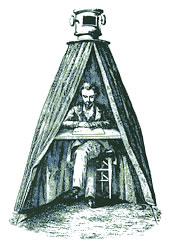 |
1611
JOHANNES KEPLER (1571 - 1630)
Kepler's
portable camera obscura (tent) is described in a paper,
'Reliquiae Wottonianae' (1st ed., London, 1651, p413)
by Sir Henry Wotton, to lord Francis Bacon. This is one of the
earliest English language descriptions given to the camera
obscura. In the paper, Wotton tells of Kepler's `tent' "which
can be moved about, totally closed and dark with a small hole
about an inch and a half in diameter". This description
comes with no illustration, and 35 years later Kircher will speak
of a similar depiction.
Kepler's
tent may have looked something like this engraving (left)
which is taken from a 19th century English encyclopedia. Henry
Wotton described this portable camera obscura of Kepler's to Francis
Bacon. |
|
|
| |
|
|
| |
|
|
| |
|
|
|
| |
|
|
|
| |
1611
- 1612
CHRISTOPHER SCHEINER (1575 - 1650)
Scheiner
used his "Pantograph" or "Helioscope" to view
sunspots (see 1610 SCHEINER). This instrument was a small portable
camera 22 metres in length with a telescope for the aperture.
It is illustrated in his 'Rosa Ursina'. Scheiner
was able to project the surface of the sun onto a piece of paper
where he could draw it. This helioptric telescope protected the
eye from damage. Scheiner and Galileo differed in their views
on these sunspots. |
|
| Scheiner's
sunspots seen through the heliograph were provided for us in his
'Rosa Ursina Sive Sol' by way of drawings (above).
Clearly the camera obscura has played a vital role in other sciences.
(Taken from William R. Shea, Scheiner, Christoph," Dictionary
of Scientific Biography; idem, "Scheiner, and the Interpretation
of Sunspots," Isis, 61 (1970):498-519). |
|
|
| |
|
|
| |
|
|
| |
|
|
|
| |
|
|
|
| |
1613
FRANCOIS D'AGUILON (1566 - 1617) |
|
|
| |
A professor of philosophy,
D'Aguilon wrote a treatise on optics and in it uses the term "Stereoscopic
Projection" (book 6). He also studies persistence of vision,
or after-images, and illusions. One extant edition of this book called
'Opticorum Libri Sex' was published in Antwerp in 1685. D'Aguilon
died in the year he was revising it. |
|
| |
|
|
|
| |
|
|
|
| |
1614
ANGELO SALA (1576 - 1637) |
|
|
| |
This German physician
and chemist published this year a small paper entitled 'Septem
Planetarum Terrestrium Spagricia Recensio', and reported that
silver nitrate in powdered form will turn black in sunlight. Silver nitrate
at the time was known as lapis lunearis, and Sala discovered that paper
would also turn black when wrapped around it. |
|
| |
|
|
|
|
|
|
|
| |
|
|
| |
|
|
| |
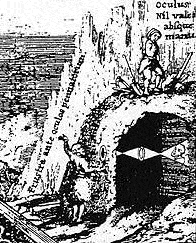 |
1619
CHRISTOPHER SCHEINER (1575 - 1650)
In
this year Scheiner describes in his book 'Oculus' (Scheiner,
1619) the camera obscura utilizing a human figure as an actor
and showing the inverted image. Scheiner, in this same manuscript
shows an illustration highlighting the use of a second lens to
invert the image.
Illustration
(left) from Scheiner's 'Oculus' of 1619.
Here he gives a clear demonstration of a room-type camera obscura
in the form of a cave or earthen hut. It clearly shows the use
of a second lens in order to erect the image.
|
|
|
| |
|
|
| |
|
|
| |
|
|
|
| |
|
|
|
| |
1619
CORNELIUS (JACOBSZOON) DREBBEL (1572 - 1633) |
|
|
| |
Drebbel was an inventor
with imagination. Besides making a compound telescope, Drebbel also developed
a machine for grinding lenses, and placed a lens in the aperture of a
camera obscura he built. He also constructed a projecting lantern. |
|
|
|
|
|
| |
|
|
|
| |
1620
SALOMON DE CAUS (1576 - 1626) |
|
|
| |
This French engineer took
the writings of Heron of Alexandria (SEE HERO AD
120) and having interpreted them, built a replica of the automaton
singing bird which Heron had only described. |
|
| |
|
|
|
| |
|
|
|
| |
 |
1626
WILLEBRORD SNELL VAN ROIJEN (1580 - 1626)
Also
VAN SNELL, and VAN ROYEN (SNELLIUS). This professor of mathematics
at Leyden discovers the law governing the refraction of light
but did not publish it. Later in 1703 Christian Huygens published
his findings in 'Dioptrica'.
|
|
|
| |
|
|
|
| |
|
|
|
| |
1626 - 30
CHRISTOPHER SCHEINER (1575 - 1650) |
|
|
| |
Scheiner began his
'Rosa Ursina Sive Sol' in 1626 and finished it in 1630. His work
included the use of the camera obscura using a telescope lens, to throw
the image of the sun and sunspots onto a screen where they could be studied
and drawn (see 1611 SCHEINER). The camera he used was housed within a
wooden box which the telescope lens was secured to. |
|
| |
|
|
|
| |
|
|
|
| |
1630
CORNELIUS (JACOBSZOON) DREBBEL (1572 - 1633) |
|
|
| |
Besides designing and
building a workable submarine, this Dutch glass maker, engraver and engineer
spoke of the camera obscura and had an important hand in the development
of the magic lantern, perhaps alongside Kircher. Drebbel also commented
on the relationship between art and the camera image. |
|
| |
|
|
|
| |
|
|
| |
|
|
| |
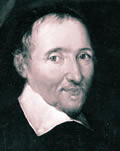 |
1631
PETRO GASSENDRO (PIERRE GASSENDI) (1592 - 1655)
This
astronomer uses the camera to observe the transit of Mercury across
the sun and describes it in his 'Institutio Astronomica'
(Gassendo, Petro, Paris, France, 1647, pp186,199).
Pierre
Gassendi |
|
|
| |
|
|
| |
|
|
| |
|
|
|
| |
|
|
|
| |
1633
JEAN LEURECHON (VAN ETTEN) (1591 - 1670) |
|
|
| |
Leucheron duplicates in
his 'Recreations Mathematiques' (Leucheron, J. Paris,
France, 1633, Trans. by William Oughtred) Scheiner's description
of a room-type camera obscura in the form of a cave or earthen hut. The
illustration which accompanies it is a reproduction from Scheiner's 'Oculus'
of 1619 and clearly shows the use of the second lens in order to erect
the image. Perhaps as a joke or social comment, Leucheron presented the
illustration upside down. SEE SCHEINER |
|
| |
|
|
|
| |
|
|
| |
1634
JOHN BATE ( - )
Bate
describes the Zoetrope in his 'Mysteries
of Nature and Art' (Bate, John, London, 1634, p30).
The work of Bate was an inspiration to Issac Newton.
|
|
|
|
| |
|
John
Bate |
|
| |
|
|
|
| |
|
|
| |
|
|
| |
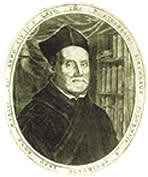 |
1635
ATHANASIUS KIRCHER (1602 - 1680)
Kircher
was a scholar at Rome who was made professor of mathematics. He
observed the sun using the camera obscura. Kircher was diverse
in his experimentations and studies as he was also involved with
hydraulic organs.
Athanasius Kircher |
|
|
| |
|
|
| |
|
|
| |
|
|
|
| |
|
|
|
| |
1636
DANIEL SCHWENTER (1585 - 1636)
This
professor of mathematics and oriental languages at Altdorf constructed
what was called a scioptric ball (today's fish-eye lens). Movement
of this lens-ball in the aperture of the camera allowed artists
to draw or paint panoramic views. Schwenter describes this lens
in his 'Deliciae Physio Mathematicae' (Schwenter, Daniel, Nurnberg,
Germany, 1651, p255). Zahn (Oculus Artificialis, Zahn, Johann,
Wurzburg, 1685-6) and Schott (Magia Universalis Naturae Et Artis,
"The Wonders of Universal Nature and Art", Schott, Kaspar, Wurzburg,
1657, p76) both speak of the lens; Zahn as "scioptric" and Schott
as "ox-eye". |
|
| Schwenter's
illustration (right) of his scioptric ball, or as he called it,
an "ox-eye lens". This lens provided the same effect as today's
fish-eye lens (-28mm). It was constructed with two lenses mounted
at opposite ends of a circular ball or sphere, made out of wood.
It was secured enough to hold the lenses in place, and would also
allow movement within, thereby providing a panoramic view of the
image being viewed such as a landscape by simply swiveling the
ball. This illustration comes from Schwenter's 'Deliciae
Physio Mathematicae', published in 1636. |
|
|
| |
|
|
| |
|
|
| |
|
|
|
| |
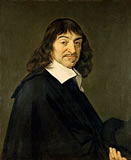 |
1637
RENE DESCARTES (RENE DU PERRON) (1596 - 1650)
Descartes
wrote in his 'La Dioptrique' (1637) about vision
and the eye. He compared the eye to the camera obscura saying
the retina is the screen of the camera. |
| |
|
|
| |
| Rene
Decartes' 1637 diagram (right) of the eye as a camera obscura.
Descartes compared the eye to the camera saying that the retina
is the same as the screen of the camera where the image resides.
On page 76 of his 'Magia Universalis', Kaspar
Schott also used the eye (of an ox), to compare with the retinal
image. |
|
|
|
| |
|
|
| |
|
|
|
|
|
|
| |
1639
JEREMIAH HORROX or HORROCKS (1617 - 1641)
This English astronomer
observed the transit of venus across the sun using the camera
obscura, 24th November. The German astronomer Kepler predicted
the event, but Horrox corrected Kepler's calculation to the exact
day of the year. |
|
|
|
| |
|
Lavender's 1903 Painting
Of The Moment
|
|
| |
|
|
| |
|
|
|
| |
|
|
|
| |
1640 - 1644
ATHANASIUS KIRCHER (1602 - 1680) |
|
|
| |
It is impossible to know
for sure, but sometime within these four years, Kircher is believed to
have presented a slide show which was projected onto a screen with illumination
from behind by a candle. In 1646 Kircher will publish his 'Ars
Magna' (1st edition, Rome) which will detail the camera
obscura and magic lantern. |
|
| |
|
|
|
| |
|
|
|
| |
1642
PIERRE HERIGONE (1580 - 1643) |
|
|
| |
This French mathematician
in his 'Supplementum Cursus Mathematici' (Herigone,
Pierre, Paris, France, 1642, Perspectives, ch6, p113) describes a
camera obscura in the form of a goblet. The drinker could keep tabs on
his guests without their knowledge. Herigone did not draw his goblet,
but Zahn would illustrate the same in his 'Oculus'. Little
else is known of Herigone excepting his work in mathematics. |
|
| |
|
|
|
| |
|
|
|
| |
|
|
| |
|
|
| |
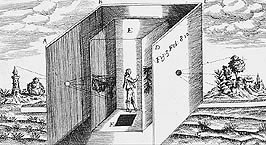 |
1646
ATHANASIUS KIRCHER (1602 - 1680)
The
most mentioned name in reference to the magic lantern, Kircher
describes it in his 'Ars Magna Lucis Et Umbra'
(The Great Art of Light and Shadow, Kircher, A., 1st ed. vol.10,
Rome, Italy, 1646) and illustrates a camera obscura of almost
room size (plate 28 of vol.10, sec. 2). In the last volume he
explains the magic lantern and it's use. Kircher describes a similar
construction of a camera to that of Wotton's description (which
was of Kepler's). Kircher also details in the book a revolving
wheel of painted pictures, something which wasn't seen again until
the 19th century. 'Ars Magna' (1st ed)
did not include any illustration of the magic lantern however
it did include a fine illustration of the camera obscura. |
| Camera
Obscura (above) from Athanasius Kircher's Ars Magna
Lucis Et Umbra (The Great Art of Light and Shadow)
1646. Originally, camera obscuras were the size of rooms and thus
take their name from the latin 'dark room'. (Ars Magna, 1st
ed. vol.10, plate 28 of vol.10, sec. 2, 1646). In this image
we can see the 'room within the room' with appropriate pinholes
where the light image strikes the interior wall where the artist
can then render his drawing. The inner wall is semi transparent,
allowing the artist to see his image before he draws it. 'F' identifies
a trap door in the floor for entry and exit. |
|
|
| |
|
|
| |
|
|
| |
|
|
| |
|
|
|
| |
|
|
|
| |
1647
ANGELO SALA (1576 - 1637) |
|
|
| |
Sala publishes the first
of two editions (2nd 1682) of his 'Opera Medica Chimicae'
in which he tells of the invention of his caustic stone or "hollenstein"
by smelting silver nitrate. |
|
| |
|
|
|
| |
|
|
|
| |
|
|
|
| |
|
|
|
| |
|
|
|
| |
| |
|
|
|
| |
|
|
|

|
| |


